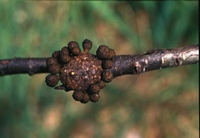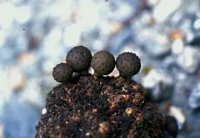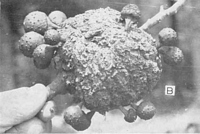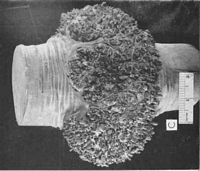|
 Cyttaria nigra Cyttaria nigra
BiostatusPresent in region - Indigenous. Endemic
Images (click to enlarge)
Owner: Hiroaki Setoguchi | 
Owner: Hiroaki Setoguchi | 
Caption: Plate 10 B. Cyttaria nigra, immature stromata to show papillae and gall on branch of Nothofagus
menziesii. (Photo A. R. Teixeira.) | 
Caption: Plate 10C. Mature stromata of Cyttaria nigra. (Photo N.Z.F.S.) | 
Caption: Plate 11 A. Decorticated Cyttaria nigra galls on Nothofagus menziesii. | 
Owner: Peter Johnston | 
Owner: Peter Johnston |
Article: Rawlings, G.B. (1956). Australasian Cyttariaceae. Transactions of the Royal Society of New Zealand 84: 19-28.
Description: Stromata solitary or in dense clusters, up to 2 cm diam, pear shaped, shagreened with black
incrustations, dry, black or black and gold, becoming pallid nigger brown. Sterile base
undifferentiated, nigger brown, striate, pleated and compressed. Hollow at maturity, internal
fibres yellow to orange, often contorted. Apothecia very numerous, up to 200 or more, pallid
white. Papillae large, prominent, scattered between apothecia, dome shaped, elevated above
surface of stroma. Pycnidia (?) profuse over entire surface, pycnospores not seen (the identity
of bodies termed pycnidia is doubtful). Asci 132-150 x 15 µ, ascospores subglobose 9.5-12.5
x 8-12 µ dark coloured in mass, spore print black. Paraphyses as long as asci, 2 µ wide,
septate, freely branched, swollen at ends.
Habitat: An obligate parasite on Nothofagus menziesii (Hook. f.) Oerst., in New Zealand, causing large
globose galls.
Distribution: Range, recorded from Southland to Lake Taupo in north. Type collection from Woodlaw
State Forest, October, 1946, in Forest Research Institute herbarium; specimens at Plant
Diseases Division of D.S.I.R. Auckland.
Notes: C. nigra comes nearest to C. espinosae Lloyd, but differs from it in colour, internal fibres and
shape of apothecia. Both species have a smell resembling apricots. Galls of C. nigra resemble
those of C. harioti. Sporophores of C. nigra occur about the same time as those of C. gunnii;
the first shedding of spores in 1946 was noted on October 10. The galls are distinguished
from those of C. gunnii by their large size in relation to the diameter of the host stem, and
their greater height in proportion to diameter. One sapling of 3 in d.b.h. had a gall at 8ft from
the ground, 30 in in circumference and 7 in high, completely encircling the stem. This was
separated by only 2 in from another, 26 in in circumference and encircling the stem except for
a space of 1 in.
Relatively larger galls are found on larger trees; galls of 3ft or more in diameter are frequent.
Where the upper part of the attacked tree or branch dies, globose galls of a foot or more in
diameter are common.
When the bark is removed the gall is seen to differ from C. gunnii in that the spines are very
short and less numerous, they arise from bluntly rounded projections on the surface of the gall.
The scar left when the fructification falls is orange in colour and may retain the orange
cartilaginous tube from the stroma.
Article: Dingley, J.M. (1969). Records of plant diseases in New Zealand. New Zealand Department of Scientific and Industrial Research, Bulletin 192: 298 p. Wellington:.
Notes: Rawlings (1956) separated this species from Cyttaria gunnii by the large globose galls
formed by the tree through an infection of this fungus: he stated that the fructifications are
darker coloured and have a smell resembling apricots. This species is endemic to New
Zealand.
Article: Gadgil, P.D. (in association with Dick, M.A.; Hood, I.A.; Pennycook, S.R.) (2005). Fungi on trees and shrubs in New Zealand. Fungi of New Zealand. Ngā Harore o Aotearoa 4: xi + 437 p. Hong Kong: Fungal Diversity Press.
Description: Type: Caulicolous Fungi; Description: Ascomata a hollow sphere, with the outer surface composed of a honeycomb of small, angular, cup-shaped ascigerous cavities, black or black and gold, up to 2 cm in diameter; borne on woody, perennial galls; galls roughly spherical, usually considerably more than twice the diameter of the host branch or stem; on larger trees, galls 1 m in diameter or more are common; gall surface under the bark with bluntly rounded projections and a few very short spines. Asci cylindrical, 140 × 15 m. Ascospores subglobose, 10 × 9 m, dark, black in mass.
Distribution: Distribution: Taupo, Buller, Westland, North Canterbury, Otago Lakes, Southland.; 1st Record: Rawlings (1956).
|